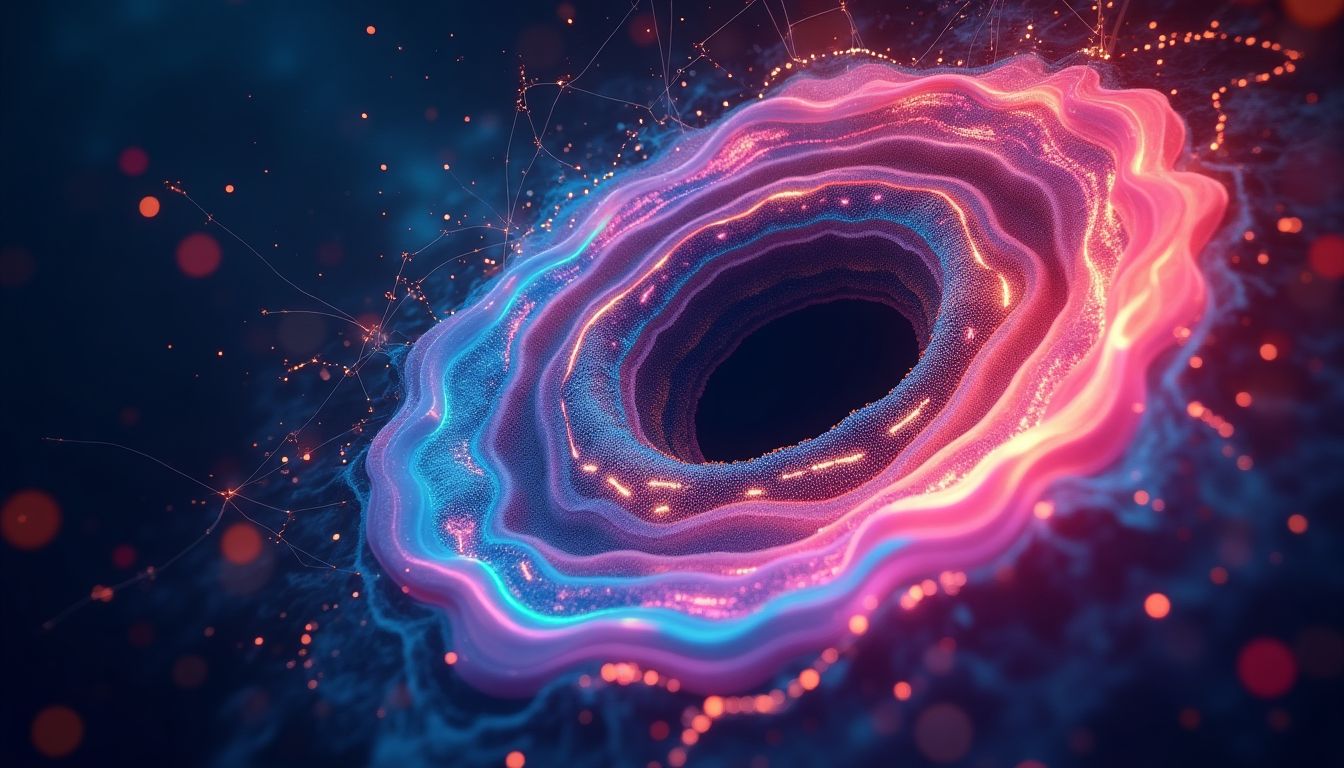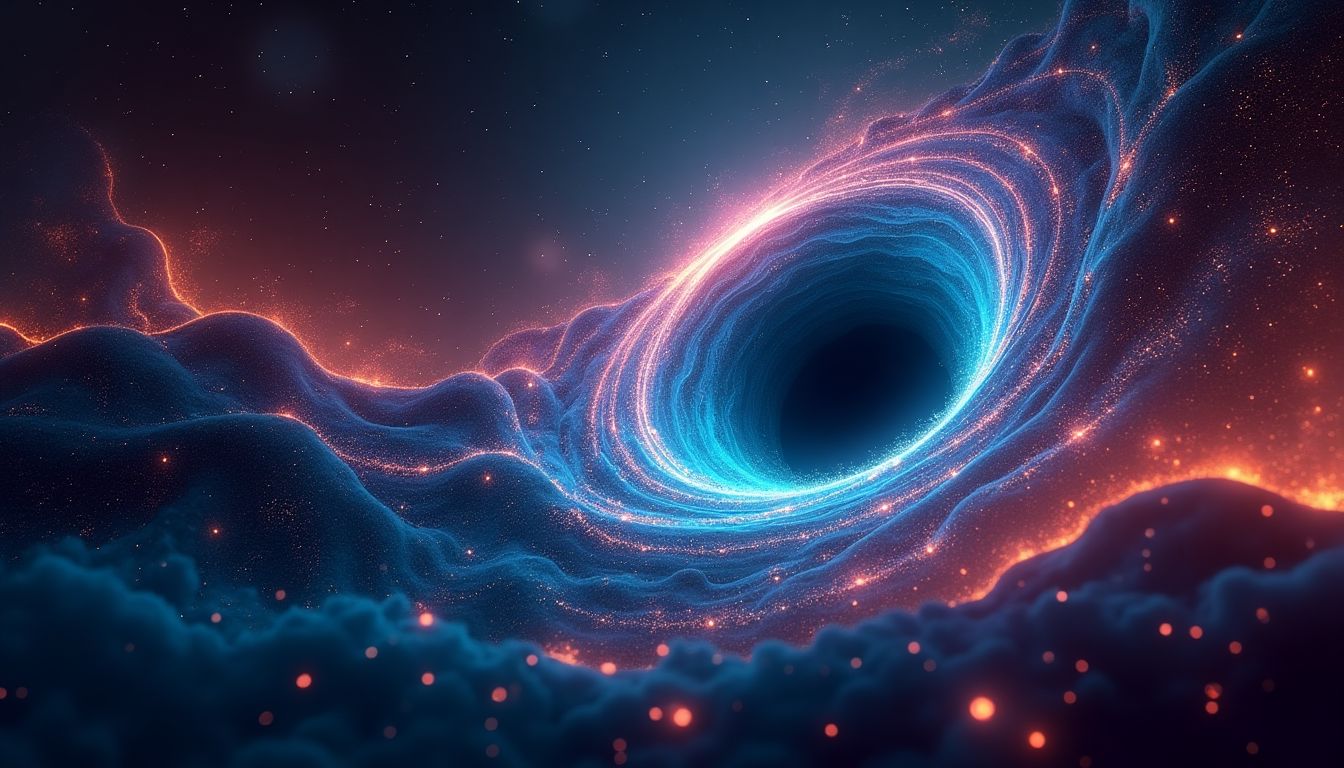Artificial Black Holes: Could AI Simulate Cosmic Singularities?
What if the key to understanding the universe’s most mysterious phenomena—black holes—wasn’t in a telescope or a particle accelerator, but in a computer? Imagine a world where artificial intelligence (AI) could recreate the extreme physics of black holes, allowing us to study their behavior, test theories of quantum gravity, and even explore the nature of spacetime itself. Could AI be the tool that finally unlocks the secrets of these cosmic enigmas?
Black holes, regions of spacetime where gravity is so intense that nothing—not even light—can escape, have fascinated scientists and dreamers alike for decades. From Stephen Hawking’s groundbreaking work on Hawking radiation to Kip Thorne’s contributions to the LIGO project that detected gravitational waves, black holes have been at the center of some of the most profound discoveries in physics. Yet, their inaccessibility and the extreme conditions they create make them nearly impossible to study directly. Enter AI: a tool capable of processing vast amounts of data, modeling complex systems, and simulating environments that are otherwise unreachable.
This article dives into the tantalizing possibility of using AI to simulate black holes. We’ll explore the challenges involved, the groundbreaking discoveries that could result, and why this might just be the most exciting frontier in modern science. Buckle up—this is going to be a wild ride through the cosmos, with a dash of humor and a whole lot of mind-bending physics.
1. The Physics of Black Holes: Why Simulate Them?
1.1 The Mystery of Singularities
Black holes are like the universe’s ultimate mystery box. They’re regions of spacetime where gravity is so strong that nothing—not even light—can escape. At their core lies a singularity, a point where the laws of physics as we know them break down. Think of it as the universe’s way of saying, “I give up.”
Stephen Hawking, the legendary physicist, once described black holes as “the ultimate prisons.” But they’re also the ultimate laboratories. Studying black holes could help us understand quantum gravity, the elusive theory that aims to unify Einstein’s theory of general relativity with quantum mechanics. It’s like trying to solve a cosmic jigsaw puzzle where half the pieces are missing.
But here’s the catch: black holes are incredibly hard to study directly. They’re invisible, and the closest one is thousands of light-years away. That’s where simulations come in. By recreating black holes in a computer, we can study their properties, test theories, and maybe even solve some of the universe’s biggest mysteries.
1.2 The Need for Simulations
Simulations are the unsung heroes of modern physics. From predicting the weather to modeling the collision of particles at CERN, simulations allow us to explore scenarios that are too complex, dangerous, or just plain impossible to study in real life. And when it comes to black holes, simulations are practically a necessity.
Why? Because black holes are extreme. They warp spacetime, create gravitational waves, and emit Hawking radiation. Trying to study them directly is like trying to study a hurricane by standing in the middle of it. Simulations let us step back and observe these cosmic phenomena from a safe distance.
But current simulations have their limits. They require massive amounts of computational power, and even then, they’re not always accurate. That’s where AI comes in. With its ability to process vast amounts of data and model complex systems, AI could take black hole simulations to the next level.
1.3 Current Simulation Efforts
Scientists have been simulating black holes for decades, using supercomputers to model their behavior. For example, the NASA-funded Simulating eXtreme Spacetimes (SXS) project has created some of the most detailed black hole simulations to date. These simulations have helped us understand everything from black hole mergers to the ripples in spacetime known as gravitational waves.
But even the best simulations have their limits. They’re computationally expensive, and they often rely on simplifications that can lead to inaccuracies. That’s where AI could make a difference. By using machine learning and neural networks, scientists could create more accurate and scalable simulations, opening up new possibilities for discovery.
So, could AI be the key to unlocking the secrets of black holes? The answer might just be a simulation away.
2. The Role of AI in Physics: A Game-Changer for Simulations
2.1 AI’s Strengths in Modeling Complex Systems
Artificial intelligence is like the Swiss Army knife of modern science. It can slice through mountains of data, carve out patterns, and even predict the future—well, at least in the world of physics. AI excels at handling complex systems, from predicting weather patterns to simulating the chaotic dance of particles in a quantum computer. When it comes to black holes, AI’s ability to process vast amounts of data and recognize patterns could be a game-changer.
Take, for example, how AI has already revolutionized fields like quantum computing and cosmology. In quantum computing, AI helps optimize qubit arrangements, while in cosmology, it’s used to analyze data from telescopes like the James Webb Space Telescope. Black holes, with their extreme conditions and chaotic behavior, are the ultimate test for AI’s modeling capabilities. If AI can crack the code of black holes, it could unlock secrets about the universe that have eluded us for decades.
2.2 Machine Learning and Neural Networks
Machine learning (ML) and neural networks are the rock stars of AI. They’re the tools that allow machines to learn from data and make predictions. In physics, ML is already being used to simulate everything from gravitational waves to the swirling chaos of accretion disks around black holes.
Imagine training a neural network to simulate the curvature of spacetime. It’s like teaching a robot to paint a masterpiece—except the canvas is the fabric of the universe. Researchers at institutions like MIT and Caltech are already using ML to model black hole mergers and predict the gravitational waves they produce. These simulations are helping us understand how black holes collide and what happens when they do.
2.3 Challenges in AI-Driven Simulations
Of course, AI isn’t a magic wand. Simulating black holes comes with its own set of challenges. For starters, AI needs accurate data to learn from. But black holes are notoriously camera-shy—they don’t exactly pose for selfies. Most of what we know comes from indirect observations, like the ripples in spacetime detected by LIGO.
Then there’s the computational power required. Simulating a black hole isn’t like running a video game on your laptop. It’s more like trying to stream 4K movies on a dial-up connection. Even with supercomputers, the calculations are mind-bogglingly complex. And let’s not forget the ethical considerations. What happens if AI makes a groundbreaking discovery that we’re not ready for? Who gets to decide how that knowledge is used?
3. Building Artificial Black Holes: The Science Behind the Simulation
3.1 Theoretical Foundations
To simulate a black hole, you need to start with the basics: Einstein’s theory of general relativity. This theory describes how massive objects like black holes warp spacetime. But general relativity is just one piece of the puzzle. You also need quantum mechanics to understand what happens at the tiniest scales, and thermodynamics to account for the heat and energy swirling around a black hole.
Key equations like Einstein’s field equations and concepts like Hawking radiation are essential for building a realistic simulation. But even with these tools, simulating a black hole is like trying to build a Lego Death Star without the instructions—it’s complicated, and you’re bound to miss a few pieces.
3.2 Simulating Spacetime and Gravity
One of the biggest challenges in black hole simulations is modeling spacetime and gravity. In the real world, spacetime is like a rubber sheet that gets stretched and twisted by massive objects. Simulating this in a computer requires solving complex equations that describe how spacetime curves around a black hole.
This is where numerical relativity comes in. It’s a branch of physics that uses computers to solve Einstein’s equations. But even with numerical relativity, simulating a black hole’s event horizon—the point of no return—is tricky. It’s like trying to map the edge of a black hole’s shadow, where light bends so much that it can’t escape.
3.3 Quantum Effects and Holography
Quantum mechanics adds another layer of complexity to black hole simulations. At the quantum level, particles can pop in and out of existence, and information can be encoded in ways that defy classical physics. This is where the holographic principle comes into play. It suggests that all the information about a black hole could be encoded on its surface, like a cosmic barcode.
AI has the potential to bridge the gap between quantum mechanics and general relativity, two theories that have been at odds for decades. By simulating quantum effects in black holes, AI could help us understand how information is preserved—or lost—when matter falls into a black hole. It’s like solving a cosmic mystery where the clues are written in a language we’re still learning to read.
4. Applications of Artificial Black Hole Simulations
4.1 Testing Theories of Quantum Gravity
One of the most exciting applications of artificial black hole simulations is their potential to test theories of quantum gravity. Quantum gravity aims to unify Einstein's theory of general relativity with quantum mechanics, two frameworks that currently don’t play well together. Black holes, with their extreme gravitational fields and quantum effects, are the perfect testing ground for these theories.
For example, simulations could help resolve the black hole information paradox, which questions whether information swallowed by a black hole is lost forever. By modeling how information might escape via Hawking radiation, AI could provide insights into whether information is truly preserved or destroyed.
- String Theory: Simulations could test predictions of string theory, such as the existence of extra dimensions or the behavior of fundamental strings near a singularity.
- Loop Quantum Gravity: AI could model how spacetime might be quantized at the smallest scales, a key prediction of loop quantum gravity.
- Holographic Principle: Simulations might reveal how black holes encode information on their surfaces, supporting the idea that our universe could be a hologram.
4.2 Advancing Astrophysics and Cosmology
Artificial black hole simulations could revolutionize our understanding of the cosmos. For instance, they could shed light on how supermassive black holes form at the centers of galaxies and influence their evolution. By simulating black hole mergers, scientists could better predict the gravitational waves these events produce, helping instruments like LIGO and Virgo detect them more accurately.
Simulations could also explore the role of black holes in the early universe. Did they seed the formation of galaxies? Could they be linked to dark matter or dark energy? These are questions that AI-driven models might answer.
| Application | Potential Impact |
|---|---|
| Galaxy Formation | Understand how black holes influence the birth and growth of galaxies. |
| Gravitational Waves | Improve detection and analysis of black hole mergers. |
| Dark Matter | Explore connections between black holes and dark matter. |
4.3 Practical Applications on Earth
While simulating black holes might sound like pure science fiction, the technology developed for these simulations could have real-world applications. For example, the algorithms used to model spacetime curvature could inspire new ways to design advanced materials or energy systems. Quantum simulations of black holes might even accelerate the development of quantum computers.
Moreover, the interdisciplinary nature of this research could lead to breakthroughs in fields like:
- Data Science: AI techniques developed for black hole simulations could improve data analysis in industries like healthcare and finance.
- Engineering: Insights into extreme physics could inspire new technologies, such as more efficient energy storage systems.
- Education: Simulations could make complex physics concepts more accessible, inspiring the next generation of scientists.
5. Ethical and Philosophical Implications
5.1 The Risks of Simulating Extreme Physics
Simulating black holes isn’t without risks. For one, there’s the potential for unintended consequences. What if a simulation inadvertently creates conditions that mimic a real black hole? While the chances are slim, the ethical implications are worth considering.
Another concern is the misuse of this technology. Could AI-driven simulations be weaponized or used to manipulate scientific consensus? The need for international oversight and ethical guidelines is clear.
- Unintended Consequences: Simulations could produce unexpected results with far-reaching implications.
- Misuse of Technology: AI models could be exploited for harmful purposes.
- Ethical Oversight: Establishing global standards to ensure responsible use of AI in physics.
5.2 The Nature of Reality and Consciousness
Simulating black holes also raises profound philosophical questions. If AI can accurately model the behavior of a black hole, does that mean we’re closer to understanding the true nature of reality? Could these simulations reveal something fundamental about consciousness or existence itself?
Some theorists, like Nick Bostrom, have even suggested that our universe might be a simulation. If AI can simulate black holes, could it one day simulate entire universes? These questions blur the line between science and philosophy, challenging us to rethink our assumptions about reality.
5.3 The Future of AI and Humanity
The collaboration between AI and physics could reshape not only science but also society. Imagine a world where AI helps us solve some of the universe’s greatest mysteries, from the nature of dark energy to the origins of life. But with great power comes great responsibility.
To ensure this future is a positive one, we need:
- Interdisciplinary Collaboration: Physicists, AI researchers, and ethicists must work together.
- Public Engagement: Educating the public about the benefits and risks of AI-driven science.
- Global Cooperation: Establishing international frameworks to guide the ethical use of AI in research.
As we stand on the brink of this new frontier, one thing is clear: the fusion of AI and physics has the potential to unlock not just the secrets of black holes, but the very fabric of reality itself.
6. AI Solutions: How Would AI Tackle This Issue?
6.1 Step-by-Step Approach
1. Data Collection and Preparation
The first step in simulating artificial black holes is gathering high-quality data. This includes observational data from telescopes like the James Webb Space Telescope, gravitational wave detectors such as LIGO, and particle accelerators like CERN. AI can then clean, organize, and analyze this data, identifying patterns and anomalies that might otherwise go unnoticed.
2. Model Development
Next, neural networks must be trained on existing black hole simulations and theoretical models. Hybrid models that combine AI with traditional numerical relativity techniques will likely yield the most accurate results. For instance, researchers at MIT and Caltech are already pioneering such approaches, blending machine learning with classical physics.
3. Simulation Execution
Running these simulations will require immense computational power. Supercomputers like Frontier or quantum computers from companies like IBM Quantum could handle the complex calculations. AI will optimize performance, ensuring simulations run efficiently and accurately.
4. Validation and Testing
Simulation results must be compared with observational data and theoretical predictions. AI can identify discrepancies and refine models iteratively, improving accuracy over time. This process is crucial for ensuring the reliability of the simulations.
5. Discovery and Application
Finally, the insights gained from these simulations can be used to test theories of quantum gravity, resolve the black hole information paradox, and even inspire new technologies. For example, understanding spacetime curvature could lead to breakthroughs in energy systems or advanced materials.
6.2 Key Technologies and Tools
- Quantum Computing: Companies like IBM and D-Wave are developing quantum computers capable of handling the complex calculations required for black hole simulations.
- Advanced Neural Networks: Transformers and Generative Adversarial Networks (GANs) can model chaotic systems like black holes with unprecedented accuracy.
- Open-Source Platforms: Tools like TensorFlow and PyTorch enable collaboration and data sharing among researchers worldwide.
6.3 Potential Challenges and Solutions
- Computational Limitations: Distributed computing and cloud resources from providers like AWS and Google Cloud can help overcome these constraints.
- Data Accuracy: Rigorous validation processes, including peer review and cross-referencing with observational data, are essential.
- Ethical Considerations: Establishing international oversight and ethical guidelines will ensure responsible use of AI-driven discoveries.
Action Schedule/Roadmap (Day 1 to Year 2)
Day 1: Assemble a multidisciplinary team of physicists, AI researchers, and ethicists. Key players could include luminaries like Kip Thorne and Leonard Susskind, alongside AI experts like Yann LeCun and Demis Hassabis.
Day 2: Secure funding and resources from governments, universities, and private organizations. Institutions like NSF and DARPA could provide critical support.
Week 1: Begin data collection from observatories, gravitational wave detectors, and particle accelerators. AI tools will process and organize this data for analysis.
Week 2: Develop initial AI models for data analysis and simulation. Use platforms like TensorFlow and PyTorch to build and train neural networks.
Month 1: Train neural networks on existing black hole simulations and theoretical models. Collaborate with institutions like Caltech and MIT to refine these models.
Month 2: Run preliminary simulations and analyze results. Use supercomputers like Frontier to handle the computational load.
Year 1: Refine models and scale up simulations using supercomputers or quantum computers. AI will optimize performance, ensuring simulations are both accurate and efficient.
Year 1.5: Validate results with observational data and theoretical predictions. Use AI to identify discrepancies and improve model accuracy.
Year 2: Publish findings and apply discoveries to practical problems in physics, engineering, and beyond. Share insights with the global scientific community through open-source platforms and collaborative networks.
Unlocking the Universe’s Secrets: The Future of AI and Black Hole Simulations
The simulation of artificial black holes using AI is not just a scientific endeavor—it’s a journey into the unknown, a quest to unravel the mysteries of the cosmos. By combining the power of AI with the insights of modern physics, we stand on the brink of discoveries that could redefine our understanding of reality. Imagine a world where we can peer into the heart of a black hole, test theories of quantum gravity, and explore the nature of spacetime itself. This is the promise of AI-driven black hole simulations.
But with great power comes great responsibility. As we push the boundaries of science, we must also consider the ethical implications of our work. How do we ensure that these discoveries are used for the benefit of humanity? How do we balance innovation with oversight? These are questions that will shape the future of AI and physics.
As we embark on this journey, let us remember the words of Stephen Hawking: “Look up at the stars and not down at your feet. Try to make sense of what you see, and wonder about what makes the universe exist.” The simulation of artificial black holes is our way of looking up, of reaching for the stars, and of daring to dream of a future where the universe’s deepest secrets are within our grasp.
What do you think? Could AI be the key to unlocking the mysteries of black holes? Share your thoughts in the comments below, and don’t forget to subscribe to our newsletter for more insights into the cutting edge of science and technology. Become a permanent resident of iNthacity: the "Shining City on the Web" and join the conversation!
Frequently Asked Questions
Q1: What is an artificial black hole?
An artificial black hole is a simulated model of a black hole created using advanced computational techniques. Think of it as a digital version of a real black hole, designed to mimic its properties and behavior without the need to venture into space. This allows scientists to study phenomena like event horizons, singularities, and Hawking radiation in a controlled environment.
Q2: Can AI really simulate a black hole?
Yes, AI has the potential to simulate black holes, but it’s not without challenges. AI excels at processing massive amounts of data and solving complex equations, making it a powerful tool for modeling extreme physics. While we’re still in the early stages, projects like those at DeepMind and collaborations with institutions like MIT are pushing the boundaries of what’s possible.
Q3: Why would we want to simulate black holes?
Simulating black holes could help us answer some of the biggest questions in physics, like how gravity and quantum mechanics work together. It could also help us understand phenomena like galaxy formation and the nature of spacetime. Plus, the technology developed for these simulations could lead to breakthroughs in fields like quantum computing and materials science.
Q4: What are the risks of simulating black holes?
Simulating black holes isn’t risk-free. There’s the potential for unintended consequences, ethical dilemmas, or even misuse of the technology. For example, if the simulations are inaccurate, they could lead to flawed scientific theories. That’s why it’s crucial to have oversight from organizations like CERN and collaboration between physicists, AI researchers, and ethicists.
Q5: How long will it take to create a reliable black hole simulation?
Creating a reliable black hole simulation could take several years, depending on advancements in AI, quantum computing, and our understanding of black hole physics. Right now, we’re laying the groundwork by collecting data from observatories like LIGO and training AI models on existing simulations. It’s a marathon, not a sprint.
Q6: What are the practical applications of black hole simulations?
The practical applications go far beyond astrophysics. For instance, the algorithms developed for black hole simulations could improve weather forecasting or optimize energy systems. Additionally, the insights gained could lead to new technologies in quantum computing, materials science, and even medicine.
Q7: Who are the key players in this field?
Several notable figures and institutions are leading the charge in black hole simulations:
- Physicists: Kip Thorne, Leonard Susskind.
- AI Researchers: Yann LeCun, Demis Hassabis.
- Institutions: CERN, MIT Technology Review.
Q8: What’s the biggest challenge in simulating black holes?
The biggest challenge is the sheer complexity of black holes. They involve extreme physics, like spacetime curvature and quantum effects, which are notoriously difficult to model. Another hurdle is computational power—simulating a black hole requires massive amounts of processing, which is why advancements in quantum computing are so crucial.
Q9: Could simulations help solve the black hole information paradox?
Absolutely! The black hole information paradox, famously highlighted by Stephen Hawking, questions whether information is lost in black holes. Simulations could help test theories like the holographic principle, which suggests that information might be encoded on the event horizon.
Q10: What’s next for AI and black hole simulations?
The next steps involve refining AI models, scaling up simulations using supercomputers, and validating results with real-world data. Collaborations between institutions like Caltech and OpenAI will be key to advancing this field. The future is bright—and full of cosmic possibilities!
Wait! There's more...check out our gripping short story that continues the journey: The Ghost in the Machine
Disclaimer: This article may contain affiliate links. If you click on these links and make a purchase, we may receive a commission at no additional cost to you. Our recommendations and reviews are always independent and objective, aiming to provide you with the best information and resources.
Get Exclusive Stories, Photos, Art & Offers - Subscribe Today!





























Post Comment
You must be logged in to post a comment.